Mochai kuzhambu, is a very easy and simple to make. It is also known as Lima beans or Field beans in English. Mochai is one of the iron and calcium rich beans (check out the health benefits below). In this recipe I have used fresh beans. Since this is a seasonal vegetable, it is available during winter season (from December). If you don’t find fresh ones in the market you can use dried beans as well, however taste differs. Fresh ones are little smaller and greenish while dried beans will be little bigger and yellow in color. This is also called as Butter beans as it has buttery texture. We can make many recipes using this beans variety like Sundal, Puli kuzhambu, Mochai Kootu etc.,
Recipe Overview: Field beans (Mochai) cooked with brinjal and Drumstick with added masala powder and finally topped with coconut and coriander leaves.
Also try other field beans recipe : Mochai Kootu - Field Beans Curry
Mochai Kootu - Field Beans Curry
.............................Have a Quick look.................................
Ingredients Needed:

- Mochai (Field Beans) – 250g
- Brinjal – 1 or 2
- Drumstick - 1
- Shallots – 5 to 6
- Tomato – 1
- Tamarind – small lemon size
- Kuzhambu Masala Powder - 1 1/2 tsp
- Shredded coconut – few
- Oil - as required
- Salt - as required
- For seasoning
- Mustard seeds – 1 tsp
- Urad dal – 1 tsp
- Onion – 1 tbsp
- Curry leaves – few
- Asafoetida– ¼ tsp
Preparation:
- First remove the beans from their pods. [Note: If you are using dried beans then soak it overnight and pressure cook for 3 whistles.]
- Make tomato puree and shallots paste.
Method:
- In a kadai add 1 cup of water then add chopped brinjal and drumstick.
- Once Veggies are half cooked, add mochai payaru (filed beans).
- Then add kuzhambu masala powder. Mix them well.
- Let it boil for next 3 to 4 minutes, then add prepared tomato puree, shallots paste and tamarind pulp.
- Now add salt and allow it to boil for another 3 minutes, then add shredded coconut and switch off the flame.
- Add chopped coriander leaves and season it with mustard seeds, urad dal, onion, Asafoetida and curry leaves.

| Author : Mano Priya Vijay |
Ingredients Needed
|
|---|
Mochai (Field Beans) – 250g
|
Brinjal – 1 or 2
|
Drumstick - 1
|
Shallots – 5 to 6
|
Kuzhambu Masala Powder - 1 1/2 tsp
|
Tomato – 1
|
Tamarind – small lemon size
|
Shredded coconut – few
|
Oil - as required
|
Salt - as required
|
For seasoning
|
Mustard seeds – 1 tsp
|
Urad dal – 1 tsp
|
Onion – 1 tbsp
|
Curry leaves – few
|
Asafoedita – ¼ tsp
|
Preparation:
- First remove the beans from their pods. [Note: If you are using dried beans then soak it overnight and pressure cook for 3 whistles.]
- Make tomato puree and shallots paste.
In a kadai add 1 cup of water then add chopped brinjal and drumstick [Note: Add water till veggies are immersed]
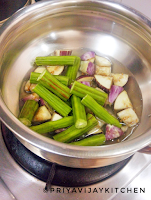
Then add homemade kuzhambu masala powder. Mix them well. [Note: If you don’t have homemade masala powder then you can use 1tsp of turmeric powder, 1 tbsp of red chilli powder, 2 tbsp of coriander powder, ¼ the tsp of cumin powder, ¼ tsp of pepper powder.]
Homemade Kuzhambu Masala Powder
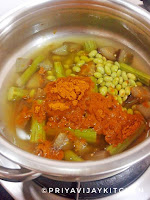
Let it boil for next 3 to 4 minutes, then add prepared tomato puree, shallots paste and tamarind pulp. [Note : Since we are adding tomato puree, shallots paste and tamarind pulp, this will increase the quantity so adding more water at the beginning will make kuzhambu watery !] [Tip: You can avoid using tamarind instead you can add 1 more tomato]
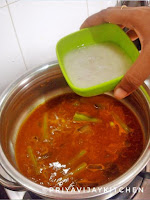
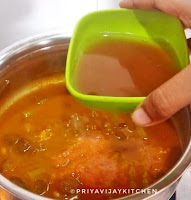
Now add salt and allow it to boil for another 3 minutes, then add shredded coconut and switch off the flame. [Note: Add salt only after the beans is well cooked ! and also switch of the flame after adding coconut.]
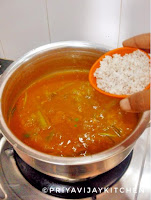
Add chopped coriander leaves and season it with mustard seeds, urad dal, onion, Asafoetida and curry leaves. [Note: Add 1/4 tsp of Asafoetida as filed beans will give gaseous effect]

Mochai Kuzhambu (Field Beans Curry) is ready !
Health benefits of each Ingredients used in this recipe:



Add chopped coriander leaves and season it with mustard seeds, urad dal, onion, Asafoetida and curry leaves. [Note: Add 1/4 tsp of Asafoetida as filed beans will give gaseous effect]

Mochai Kuzhambu (Field Beans Curry) is ready !
In Tamil there is a saying “Unavae Marunthu, Marunthae Unavu” means “Food is Medicine, Medicine is Food”. In respect to the saying, each and every food we intake in our day to day life has lots of health benefits excluding junk foods and tin packed foods, of course they contain preservatives which is unhealthy.
In Indian cuisines, we use lot of ingredients in our making of recipes, which benefits us in many ways. We use them not only for their flavor and taste but for its nutritional and medicinal value as well. If we look deeper into the traditional way of cooking, all the ingredients used in each recipes are well balanced both nutritionally and medicinally.
Each ingredients have many many health benefits but without knowing their health benefits we are using them daily. Let us know at least their important health benefits before we use and eat.
Here I have listed the health benefits of each ingredients I used in the recipe.
Ingredient 1:
Field Beans – also known as Field beans or Lima beans in English, Mochai in Tamil, Anumulu in Telugu, Avrekai in Kannada, Amarapayar in Malayalam, Vaal in Hindi. It belongs to beans variety. It has high amount of proteins and it has many medicinal values as well. Since it produces gastric problems it is better to include either garlic or ginger or asafetida (perungaayam) in the dish. It is rich in calcium and iron, hence it highly recommended for pregnant women. It helps to control blood sugar, helps in digestion as it contains potassium, act as antioxidant which helps our skin glow.
Ingredient 2:
Shallots – known as Chinna Vengayam in Tamil, Ulli in Malayalam, Ullipaaya in Telugu, Chikk-Eerulli in Kannada, Chotta Pyaz in Hindi. Shallots are one of the variety of onions and it belongs to the family of garlic and onions. In Indian cuisine shallots place a major role. They not only have high nutritional value, also have high medicinal value. They are used in the healing process in Ayurveda treatment. Shallots makes our body cool ie., it have cooling effect on the body hence they help in lowering inflammation, swelling etc., In simple words we can put it as shallots are Anti-inflammatory, Antioxidant, helps in lowering cholesterol, maintain blood pressure, to control diabetics.
Ingredient 3:
Gingerly Oil – also known as Nallenai in Tamil, Nuvalu Nuna in Telugu, Nallenna in Malayalam, Ellenai in Kannada, Thil Ka Tel in Hindi. Gingerly oil have significant health benefits. South Indians widely use gingerly oil in their cooking. It is a good source of Vitamin D, E and B complex and antioxidants. Apart from it they are also used in cosmetic purposes, as they promotes healthy skin, reduces pimples and rashes by preventing bacterial infections, very good factor of gingerly oil is, it slows down aging of skin. We, the Tamilians have a tradition of taking oil bath (using gingerly oil) every Saturday by massaging the entire body and head. Massaging removes toxins from you and leaves you detoxified and bathing removes heat from the body. We religiously follow this tradition where new borns also have no exception.
Ingredient 4:
Salt – also known as Uppu in Tamil, Telugu, Kannada & Malayalam, Namak in Hindi. There is a saying in Tamil, “Uppu Illa sapadu kuppaiyile” meaning “Food (sapadu) without salt goes to garbage (kuppai)”. That’s show how salt is an important ingredient. Salt known as sodium chloride used as a seasoning agent in almost all recipes daily. Salt helps in digestion, improves cardiovascular health, improves hydration, helps in healthy respiratory system, vital for electrolyte balance. Salt also have negativites if taken in excess, can increase blood pressure, can lead to heart disease and stroke.
Ingredient 5:
Coconut – also known as Thengai in Tamil, Kobbari Kaaya in Telugu, Thenginakai in Kannada, Thenga in Malayalam, Nariyal in Hindi. Coconut which can be used in different forms starting from tender coconut water, coconut water, coconut oil, coconut milk and many more. Tender coconut which has lots of benefits which we can look after it separately. Fresh coconut water is sweat in taste and are tremendously beneficial to health. Coconuts are one of the main ingredients in Indian cuisines which are widely used in preparing chutneys. Cocnuts are anti-viral, anti-bacterial, boosts immune systems, rich in fiber, controls diabetics by improving insulin secretion, improves good cholesterol, has good source of vitamins (C, E, B1, B5 etc.,) and minerals (iron, calcicum etc.,) to maintain a healthy skin and healthy hair.
Ingredient 6:
Brinjal – also known as Kathirikai in Tamil, Vankaya in Telugu, Badanekai in Kannada, Vazhuthananga in Malayalam, Baingan in Hindi. It is also called as Egg plant may be it resembles the shape of an Egg . It has many mumber of vitamins, minerals, fibers etc., Since it is rich in fiber it improves digestion, helps to reduce weight since it has no fat or cholesterol, improves bone health, prevent cancer, anemia, improve brain function. Although it is packed with vitamins & minerals consuming lot of eggplant may stimulate menstruation, hence pregnant women should avoid eating it lot, also it may cause itchiness, rashes for some people who are allergic.
Ingredient 7:
Drumstick – also known as Muringakkai in Tamil, Munagakayalu in Telugu, Nuggekai in Kannada, Muringakkaya in Malayalam, Sojni Ki Phalli in Hindi. Murungaikai means twisted pod. It is widely used in South Indian cuisines starting from sambar, aviyal, poriyal, kootu etc., It prevents diabetics as they help to reduce blood sugar levels, high in vitamin C thus fights cough and cold, sore throat, helps to build strong bones as they are rich in calcium and also enhances sexual health.
Ingredient 8:
Tomato - also known as Thakkali in Tamil, Goore Hannu in Kannada, Tamatar in Hindi, Tamata in Telugu. Tomato is considered to be both fruit and vegetables are nutrient rich which supports healthful skin, reduces risk of heart disease, great source of vitamin C and Fiber, great source of Antioxidant. When comes to healthy skin, I must talk about the beauty tips. Apply raw tomato to acne for shrinkage. Mash and mix it honey to form a paste and use a mask and rinse off after 15 minutes.
Ingredient 9:
Tamarind – also known as Puli in Tamil and Malayalam, Chinthapandu in Telugu, Huli in Kannada, Imli in Hindi. Tamarind is a kind of fruit with have sweet and sour taste. Tamarind plays a major role in South Indian cooking, after cooking each dishes we used to ask Uppu (salt), Puli (Tamarind), Karam (Spiciness) correct ah irrukka? means if the saltness, sourness and spiciness is in correct level in the dish? That’s how puli plays major role in south indian cuisine. It improves digestion, aids weight loss, boosts immunity, rich source of vitamin C
Ingredient 10:
Homemade Masala Powder – This masala powder is a mix of total 11 ingredients - Whole Dried Turmeric, Dry Red Chili, Coriander seeds, Cumin seeds, Fenugreek, Mustard seeds, Pepper Corns, Toor Dal, Urad Dal, Rice, Whole Asafoetida stones. I have included health benefits of each ingredients in that recipe. Please take a look at it to see the health benefits of these 11 ingredients. Link - Homemade Masala Powder
Ingredient 11:
Ingredient 15:
Asafoetida – also known as Perungaayam in Tamil, Inguva in Telugu, Hingu in Kannada, Kaayam in Malayalam, Hing in Hindi. Asafoetida have distinct flavor and aroma. It is a key ingredient in Indian cuisines used mostly in curries and dal. It has very high medicinal value apart from its health benefits. It is mainly used in home remedies for stomach upset & intestinal gas. Whenever we prepare dal, we use to season it with asafetida in order to balance the gaseous effort dal produce. It’s a natural cure for asthma and bronchitis, relieves menstrual pain, cures ear aches, heals insects bites.
In Indian cuisines, we use lot of ingredients in our making of recipes, which benefits us in many ways. We use them not only for their flavor and taste but for its nutritional and medicinal value as well. If we look deeper into the traditional way of cooking, all the ingredients used in each recipes are well balanced both nutritionally and medicinally.
Each ingredients have many many health benefits but without knowing their health benefits we are using them daily. Let us know at least their important health benefits before we use and eat.
Here I have listed the health benefits of each ingredients I used in the recipe.
Ingredient 1:
Field Beans – also known as Field beans or Lima beans in English, Mochai in Tamil, Anumulu in Telugu, Avrekai in Kannada, Amarapayar in Malayalam, Vaal in Hindi. It belongs to beans variety. It has high amount of proteins and it has many medicinal values as well. Since it produces gastric problems it is better to include either garlic or ginger or asafetida (perungaayam) in the dish. It is rich in calcium and iron, hence it highly recommended for pregnant women. It helps to control blood sugar, helps in digestion as it contains potassium, act as antioxidant which helps our skin glow.
Ingredient 2:
Shallots – known as Chinna Vengayam in Tamil, Ulli in Malayalam, Ullipaaya in Telugu, Chikk-Eerulli in Kannada, Chotta Pyaz in Hindi. Shallots are one of the variety of onions and it belongs to the family of garlic and onions. In Indian cuisine shallots place a major role. They not only have high nutritional value, also have high medicinal value. They are used in the healing process in Ayurveda treatment. Shallots makes our body cool ie., it have cooling effect on the body hence they help in lowering inflammation, swelling etc., In simple words we can put it as shallots are Anti-inflammatory, Antioxidant, helps in lowering cholesterol, maintain blood pressure, to control diabetics.
Ingredient 3:
Gingerly Oil – also known as Nallenai in Tamil, Nuvalu Nuna in Telugu, Nallenna in Malayalam, Ellenai in Kannada, Thil Ka Tel in Hindi. Gingerly oil have significant health benefits. South Indians widely use gingerly oil in their cooking. It is a good source of Vitamin D, E and B complex and antioxidants. Apart from it they are also used in cosmetic purposes, as they promotes healthy skin, reduces pimples and rashes by preventing bacterial infections, very good factor of gingerly oil is, it slows down aging of skin. We, the Tamilians have a tradition of taking oil bath (using gingerly oil) every Saturday by massaging the entire body and head. Massaging removes toxins from you and leaves you detoxified and bathing removes heat from the body. We religiously follow this tradition where new borns also have no exception.
Ingredient 4:
Salt – also known as Uppu in Tamil, Telugu, Kannada & Malayalam, Namak in Hindi. There is a saying in Tamil, “Uppu Illa sapadu kuppaiyile” meaning “Food (sapadu) without salt goes to garbage (kuppai)”. That’s show how salt is an important ingredient. Salt known as sodium chloride used as a seasoning agent in almost all recipes daily. Salt helps in digestion, improves cardiovascular health, improves hydration, helps in healthy respiratory system, vital for electrolyte balance. Salt also have negativites if taken in excess, can increase blood pressure, can lead to heart disease and stroke.
Ingredient 5:
Coconut – also known as Thengai in Tamil, Kobbari Kaaya in Telugu, Thenginakai in Kannada, Thenga in Malayalam, Nariyal in Hindi. Coconut which can be used in different forms starting from tender coconut water, coconut water, coconut oil, coconut milk and many more. Tender coconut which has lots of benefits which we can look after it separately. Fresh coconut water is sweat in taste and are tremendously beneficial to health. Coconuts are one of the main ingredients in Indian cuisines which are widely used in preparing chutneys. Cocnuts are anti-viral, anti-bacterial, boosts immune systems, rich in fiber, controls diabetics by improving insulin secretion, improves good cholesterol, has good source of vitamins (C, E, B1, B5 etc.,) and minerals (iron, calcicum etc.,) to maintain a healthy skin and healthy hair.
Ingredient 6:
Brinjal – also known as Kathirikai in Tamil, Vankaya in Telugu, Badanekai in Kannada, Vazhuthananga in Malayalam, Baingan in Hindi. It is also called as Egg plant may be it resembles the shape of an Egg . It has many mumber of vitamins, minerals, fibers etc., Since it is rich in fiber it improves digestion, helps to reduce weight since it has no fat or cholesterol, improves bone health, prevent cancer, anemia, improve brain function. Although it is packed with vitamins & minerals consuming lot of eggplant may stimulate menstruation, hence pregnant women should avoid eating it lot, also it may cause itchiness, rashes for some people who are allergic.
Ingredient 7:
Drumstick – also known as Muringakkai in Tamil, Munagakayalu in Telugu, Nuggekai in Kannada, Muringakkaya in Malayalam, Sojni Ki Phalli in Hindi. Murungaikai means twisted pod. It is widely used in South Indian cuisines starting from sambar, aviyal, poriyal, kootu etc., It prevents diabetics as they help to reduce blood sugar levels, high in vitamin C thus fights cough and cold, sore throat, helps to build strong bones as they are rich in calcium and also enhances sexual health.
Ingredient 8:
Tomato - also known as Thakkali in Tamil, Goore Hannu in Kannada, Tamatar in Hindi, Tamata in Telugu. Tomato is considered to be both fruit and vegetables are nutrient rich which supports healthful skin, reduces risk of heart disease, great source of vitamin C and Fiber, great source of Antioxidant. When comes to healthy skin, I must talk about the beauty tips. Apply raw tomato to acne for shrinkage. Mash and mix it honey to form a paste and use a mask and rinse off after 15 minutes.
Ingredient 9:
Tamarind – also known as Puli in Tamil and Malayalam, Chinthapandu in Telugu, Huli in Kannada, Imli in Hindi. Tamarind is a kind of fruit with have sweet and sour taste. Tamarind plays a major role in South Indian cooking, after cooking each dishes we used to ask Uppu (salt), Puli (Tamarind), Karam (Spiciness) correct ah irrukka? means if the saltness, sourness and spiciness is in correct level in the dish? That’s how puli plays major role in south indian cuisine. It improves digestion, aids weight loss, boosts immunity, rich source of vitamin C
Ingredient 10:
Homemade Masala Powder – This masala powder is a mix of total 11 ingredients - Whole Dried Turmeric, Dry Red Chili, Coriander seeds, Cumin seeds, Fenugreek, Mustard seeds, Pepper Corns, Toor Dal, Urad Dal, Rice, Whole Asafoetida stones. I have included health benefits of each ingredients in that recipe. Please take a look at it to see the health benefits of these 11 ingredients. Link - Homemade Masala Powder
Ingredient 11:
Mustard seeds – also known as Kadugu in Tamil and Malayalam, Avalu in Telugu, Rai in Hindi. Mustard seeds are most probably used by all people all over the world in some or other form either via seeds or by oil or as sauce used in their recipes. We south Indian people use it as whole seeds. They are mostly used for seasoning the dishes. It is a high nutritious seeds rich in calcium, protein, manganese, iron, zinc, omega 3 fatty acids and dietary fiber. Mustard oil helps in Hair growth, hair loss, hydrates skin, and acts as a natural scrubber.
Ingredient 12:
Urad dal – also known as Black gram in English, Ulundhu in Tamil, Uddulu in Telugu, Uddu in Kannada, Uzhunnu in Malayalam, Urad in Hindi. Like other dal varieties, urad dal is rich in fiber, helps in strengthening your back bone (South Indian culture is to give dishes made out of black gram for girl children once they attain puberty to strengthen their bones), helps in iron deficiency, reduces risk of heart disease, helps to stabilize blood sugar levels, prevent constipation.
Ingredient 13:
Onion – also known as Vengayam in Tamil, Nirulli in Telugu, Savala in Malayalam, Neeruli in Kannada. Onions are mostly used in all cuisines all over the world. In Indian cuisines, onion and tomato plays a major role, where onion is the base for most of the recipes. Eating raw onions have more health benefits compared to cooked one. Onions protects our immune system, prevent cancer, helps in digestion as it is rich in fiber, Anti-bacterial and Anti-inflammatory.
Ingredient 14:
Curry Leaves – also known as Kariveppilai in Tamil, Karivepaku in Telugu, Karibevu in Kannada, Kariveppila in Malayalam, Kadi Patta in Hindi. Curry leaves, I should call it as a magical leaves, because it has numerous health benefits. For children this curry leaves would be annoying leaf even for me when I am kid. We the South Indians use curry leaves daily in almost every recipes we prepare, we use it while seasoning the food. When we say its health benefits, the first thing strikes our mind is that it is good for long and strong hair, apart from that there are many more. It stops diarrhea, helps in digestion, lowers cholesterol levels and blood sugar levels, good for eyesight, rich in Vitamin C thus help to clean your blood, leaving skin fresh and healthy, rich in calcium, iron. Tip: 1. Mix curry leaves powder with buttermilk for stomach upset. 2. Having curry leaves with lemon juice clears off morning sickness in pregnant women.Ingredient 12:
Urad dal – also known as Black gram in English, Ulundhu in Tamil, Uddulu in Telugu, Uddu in Kannada, Uzhunnu in Malayalam, Urad in Hindi. Like other dal varieties, urad dal is rich in fiber, helps in strengthening your back bone (South Indian culture is to give dishes made out of black gram for girl children once they attain puberty to strengthen their bones), helps in iron deficiency, reduces risk of heart disease, helps to stabilize blood sugar levels, prevent constipation.
Ingredient 13:
Onion – also known as Vengayam in Tamil, Nirulli in Telugu, Savala in Malayalam, Neeruli in Kannada. Onions are mostly used in all cuisines all over the world. In Indian cuisines, onion and tomato plays a major role, where onion is the base for most of the recipes. Eating raw onions have more health benefits compared to cooked one. Onions protects our immune system, prevent cancer, helps in digestion as it is rich in fiber, Anti-bacterial and Anti-inflammatory.
Ingredient 14:
Ingredient 15:
Asafoetida – also known as Perungaayam in Tamil, Inguva in Telugu, Hingu in Kannada, Kaayam in Malayalam, Hing in Hindi. Asafoetida have distinct flavor and aroma. It is a key ingredient in Indian cuisines used mostly in curries and dal. It has very high medicinal value apart from its health benefits. It is mainly used in home remedies for stomach upset & intestinal gas. Whenever we prepare dal, we use to season it with asafetida in order to balance the gaseous effort dal produce. It’s a natural cure for asthma and bronchitis, relieves menstrual pain, cures ear aches, heals insects bites.



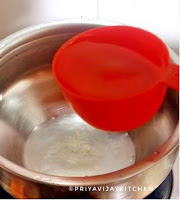

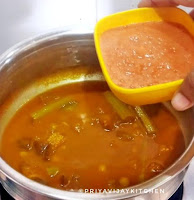



No comments:
Post a Comment